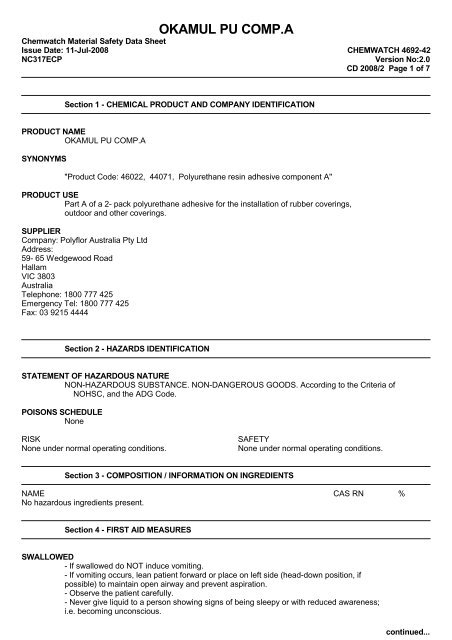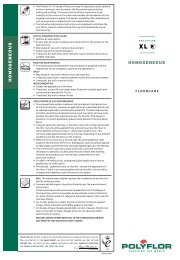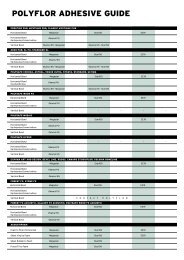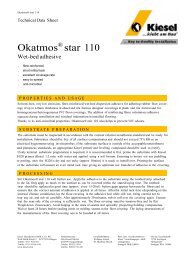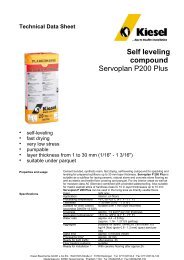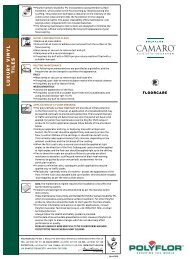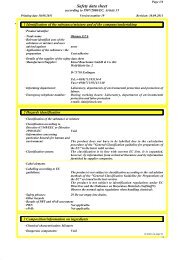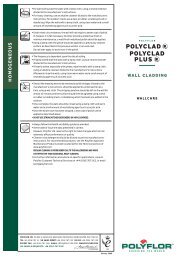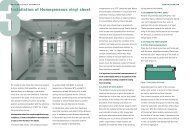MSDS Part 1 - Polyflor
MSDS Part 1 - Polyflor
MSDS Part 1 - Polyflor
You also want an ePaper? Increase the reach of your titles
YUMPU automatically turns print PDFs into web optimized ePapers that Google loves.
OKAMUL PU COMP.A<br />
Chemwatch Material Safety Data Sheet<br />
Issue Date: 11-Jul-2008 CHEMWATCH 4692-42<br />
NC317ECP Version No:2.0<br />
CD 2008/2 Page 1 of 7<br />
Section 1 - CHEMICAL PRODUCT AND COMPANY IDENTIFICATION<br />
PRODUCT NAME<br />
OKAMUL PU COMP.A<br />
SYNONYMS<br />
"Product Code: 46022, 44071, Polyurethane resin adhesive component A"<br />
PRODUCT USE<br />
<strong>Part</strong> A of a 2- pack polyurethane adhesive for the installation of rubber coverings,<br />
outdoor and other coverings.<br />
SUPPLIER<br />
Company: <strong>Polyflor</strong> Australia Pty Ltd<br />
Address:<br />
59- 65 Wedgewood Road<br />
Hallam<br />
VIC 3803<br />
Australia<br />
Telephone: 1800 777 425<br />
Emergency Tel: 1800 777 425<br />
Fax: 03 9215 4444<br />
Section 2 - HAZARDS IDENTIFICATION<br />
STATEMENT OF HAZARDOUS NATURE<br />
NON-HAZARDOUS SUBSTANCE. NON-DANGEROUS GOODS. According to the Criteria of<br />
NOHSC, and the ADG Code.<br />
POISONS SCHEDULE<br />
None<br />
RISK SAFETY<br />
None under normal operating conditions. None under normal operating conditions.<br />
Section 3 - COMPOSITION / INFORMATION ON INGREDIENTS<br />
NAME CAS RN %<br />
No hazardous ingredients present.<br />
Section 4 - FIRST AID MEASURES<br />
SWALLOWED<br />
- If swallowed do NOT induce vomiting.<br />
- If vomiting occurs, lean patient forward or place on left side (head-down position, if<br />
possible) to maintain open airway and prevent aspiration.<br />
- Observe the patient carefully.<br />
- Never give liquid to a person showing signs of being sleepy or with reduced awareness;<br />
i.e. becoming unconscious.<br />
continued...
OKAMUL PU COMP.A<br />
Chemwatch Material Safety Data Sheet<br />
Issue Date: 11-Jul-2008 CHEMWATCH 4692-42<br />
NC317ECP Version No:2.0<br />
CD 2008/2 Page 2 of 7<br />
Section 4 - FIRST AID MEASURES<br />
EYE<br />
SKIN<br />
INHALED<br />
- Give water to rinse out mouth, then provide liquid slowly and as much as casualty can<br />
comfortably drink.<br />
- Seek medical advice.<br />
If this product comes in contact with the eyes:<br />
- Wash out immediately with fresh running water.<br />
- Ensure complete irrigation of the eye by keeping eyelids apart and away from eye and<br />
moving the eyelids by occasionally lifting the upper and lower lids.<br />
- If pain persists or recurs seek medical attention.<br />
- Removal of contact lenses after an eye injury should only be undertaken by skilled<br />
personnel.<br />
If skin or hair contact occurs:<br />
- Flush skin and hair with running water (and soap if available).<br />
- Seek medical attention in event of irritation.<br />
- If fumes or combustion products are inhaled remove from contaminated area.<br />
- Lay patient down. Keep warm and rested.<br />
- Prostheses such as false teeth, which may block airway, should be removed, where<br />
possible, prior to initiating first aid procedures.<br />
- Apply artificial respiration if not breathing, preferably with a demand valve<br />
resuscitator, bag-valve mask device, or pocket mask as trained. Perform CPR if necessary.<br />
- Transport to hospital, or doctor.<br />
NOTES TO PHYSICIAN<br />
Treat symptomatically.<br />
Section 5 - FIRE FIGHTING MEASURES<br />
EXTINGUISHING MEDIA<br />
- Foam.<br />
- Dry chemical powder.<br />
- BCF (where regulations permit).<br />
- Carbon dioxide.<br />
- Water spray or fog - Large fires only.<br />
FIRE FIGHTING<br />
- Alert Fire Brigade and tell them location and nature of hazard.<br />
- Wear breathing apparatus plus protective gloves.<br />
- Prevent, by any means available, spillage from entering drains or water course.<br />
- Use water delivered as a fine spray to control fire and cool adjacent area.<br />
- Avoid spraying water onto liquid pools.<br />
- Do not approach containers suspected to be hot.<br />
- Cool fire exposed containers with water spray from a protected location.<br />
- If safe to do so, remove containers from path of fire.<br />
FIRE/EXPLOSION HAZARD<br />
- Combustible.<br />
- Slight fire hazard when exposed to heat or flame.<br />
- Heating may cause expansion or decomposition leading to violent rupture of containers.<br />
- On combustion, may emit toxic fumes of carbon monoxide (CO).<br />
- May emit acrid smoke.<br />
- Mists containing combustible materials may be explosive.<br />
continued...
OKAMUL PU COMP.A<br />
Chemwatch Material Safety Data Sheet<br />
Issue Date: 11-Jul-2008 CHEMWATCH 4692-42<br />
NC317ECP Version No:2.0<br />
CD 2008/2 Page 3 of 7<br />
Section 5 - FIRE FIGHTING MEASURES<br />
FIRE INCOMPATIBILITY<br />
- Avoid contamination with oxidising agents i.e. nitrates, oxidising acids, chlorine<br />
bleaches, pool chlorine etc. as ignition may result.<br />
HAZCHEM: None<br />
Section 6 - ACCIDENTAL RELEASE MEASURES<br />
EMERGENCY PROCEDURES<br />
MINOR SPILLS<br />
- Clean up all spills immediately.<br />
- Avoid contact with skin and eyes.<br />
- Wear impervious gloves and safety goggles.<br />
- Trowel up/scrape up.<br />
- Place spilled material in clean, dry, sealed container.<br />
- Flush spill area with water.<br />
MAJOR SPILLS<br />
Minor hazard.<br />
- Clear area of personnel.<br />
- Alert Fire Brigade and tell them location and nature of hazard.<br />
- Control personal contact by using protective equipment as required.<br />
- Prevent spillage from entering drains or water ways.<br />
- Contain spill with sand, earth or vermiculite.<br />
- Collect recoverable product into labelled containers for recycling.<br />
- Absorb remaining product with sand, earth or vermiculite and place in appropriate<br />
containers for disposal.<br />
- Wash area and prevent runoff into drains or waterways.<br />
- If contamination of drains or waterways occurs, advise emergency services.<br />
Personal Protective Equipment advice is contained in Section 8 of the <strong>MSDS</strong>.<br />
Section 7 - HANDLING AND STORAGE<br />
PROCEDURE FOR HANDLING<br />
Remove all ignition sources.<br />
- Limit all unnecessary personal contact.<br />
- Wear protective clothing when risk of exposure occurs.<br />
- Use in a well-ventilated area.<br />
- When handling DO NOT eat, drink or smoke.<br />
- Always wash hands with soap and water after handling.<br />
- Avoid physical damage to containers.<br />
- Use good occupational work practice.<br />
- Observe manufacturer's storing and handling recommendations.<br />
SUITABLE CONTAINER<br />
- Polyethylene or polypropylene container.<br />
- Check all containers are clearly labelled and free from leaks.<br />
STORAGE INCOMPATIBILITY<br />
- Avoid reaction with oxidising agents.<br />
continued...
OKAMUL PU COMP.A<br />
Chemwatch Material Safety Data Sheet<br />
Issue Date: 11-Jul-2008 CHEMWATCH 4692-42<br />
NC317ECP Version No:2.0<br />
CD 2008/2 Page 4 of 7<br />
Section 7 - HANDLING AND STORAGE<br />
STORAGE REQUIREMENTS<br />
- Keep dry.<br />
- Store under cover.<br />
- Store in a well ventilated area.<br />
- Store away from sources of heat or ignition.<br />
- Observe manufacturer's storing and handling recommendations.<br />
Section 8 - EXPOSURE CONTROLS / PERSONAL PROTECTION<br />
EXPOSURE CONTROLS<br />
MATERIAL DATA<br />
None assigned.<br />
PERSONAL PROTECTION<br />
EYE<br />
- Safety glasses with side shields; or as required,<br />
- Chemical goggles.<br />
- Contact lenses may pose a special hazard; soft contact lenses may absorb and<br />
concentrate irritants. A written policy document, describing the wearing of lens or<br />
restrictions on use, should be created for each workplace or task. This should include a<br />
review of lens absorption and adsorption for the class of chemicals in use and an account<br />
of injury experience. Medical and first-aid personnel should be trained in their removal<br />
and suitable equipment should be readily available. In the event of chemical exposure,<br />
begin eye irrigation immediately and remove contact lens as soon as practicable. Lens<br />
should be removed at the first signs of eye redness or irritation - lens should be<br />
removed in a clean environment only after workers have washed hands thoroughly. [CDC<br />
NIOSH Current Intelligence Bulletin 59].<br />
HANDS/FEET<br />
- Wear chemical protective gloves, eg. PVC.<br />
- Wear safety footwear or safety gumboots, eg. Rubber.<br />
OTHER<br />
- Overalls.<br />
- Eyewash unit.<br />
RESPIRATOR<br />
Selection of the Class and Type of respirator will depend upon the level of breathing<br />
zone contaminant and the chemical nature of the contaminant. Protection Factors (defined<br />
as the ratio of contaminant outside and inside the mask) may also be important.<br />
Breathing Zone Level Maximum Protection Half- face Respirator Full- Face Respirator<br />
ppm (volume) Factor<br />
1000 10 - AUS P -<br />
1000 50 - - AUS P<br />
5000 50 Airline * -<br />
5000 100 - - 2 P<br />
10000 100 - - 3 P<br />
100+ Airline**<br />
* - Continuous Flow ** - Continuous-flow or positive pressure demand.<br />
The local concentration of material, quantity and conditions of use determine the type of<br />
continued...
OKAMUL PU COMP.A<br />
Chemwatch Material Safety Data Sheet<br />
Issue Date: 11-Jul-2008 CHEMWATCH 4692-42<br />
NC317ECP Version No:2.0<br />
CD 2008/2 Page 5 of 7<br />
Section 8 - EXPOSURE CONTROLS / PERSONAL PROTECTION<br />
personal protective equipment required.<br />
For further information consult site specific<br />
CHEMWATCH data (if available), or your<br />
Occupational Health and Safety Advisor.<br />
ENGINEERING CONTROLS<br />
General exhaust is adequate under normal operating conditions. If risk of overexposure<br />
exists, wear SAA approved respirator. Correct fit is essential to obtain adequate<br />
protection. Provide adequate ventilation in warehouse or closed storage areas.<br />
Refer also to protective measures for the other component used with the product. Read<br />
both <strong>MSDS</strong> before using; store and attach <strong>MSDS</strong> together.<br />
Section 9 - PHYSICAL AND CHEMICAL PROPERTIES<br />
APPEARANCE<br />
Beige paste with characteristic odour; does not mix with water.<br />
PHYSICAL PROPERTIES<br />
Does not mix with water.<br />
Sinks in water.<br />
Molecular Weight: Not Applicable Boiling Range (°C): Not Av ailable<br />
Melting Range (°C): Not Available Specific Gravity (water= 1): 1.53<br />
Solubility in water (g/L): Immiscible pH (as supplied): Not Applicable<br />
pH (1% solution): Not Applicable Vapour Pressure (kPa): Negligible<br />
Volatile Component (%vol): Not Available Evaporation Rate: Not Available<br />
Relative Vapour Density (air=1): Not Available Flash Point (°C): >200<br />
Lower Explosive Limit (%): Not Available Upper Explosive Limit (%): Not Available<br />
Autoignition Temp (°C): Not Available Decomposition Temp ( °C): Not Available<br />
State: Non Slump Paste Viscosity: 700000- 800000 cSt@ 20°C<br />
Section 10 - CHEMICAL STABILITY AND REACTIVITY INFORMATION<br />
CONDITIONS CONTRIBUTING TO INSTABILITY<br />
- Presence of incompatible materials.<br />
- Product is considered stable.<br />
- Hazardous polymerisation will not occur.<br />
Section 11 - TOXICOLOGICAL INFORMATION<br />
POTENTIAL HEALTH EFFECTS<br />
ACUTE HEALTH EFFECTS<br />
SWALLOWED<br />
The material has NOT been classified by EC Directives or other classification systems as<br />
"harmful by ingestion". This is because of the lack of corroborating animal or human<br />
evidence. The material may still be damaging to the health of the individual, following<br />
ingestion, especially where pre-existing organ (eg. liver, kidney) damage is evident.<br />
Present definitions of harmful or toxic substances are generally based on doses producing<br />
mortality rather than those producing morbidity (disease, ill-health). Gastrointestinal<br />
tract discomfort may produce nausea and vomiting. In an occupational setting however,<br />
ingestion of insignificant quantities is not thought to be cause for concern.<br />
continued...
OKAMUL PU COMP.A<br />
Chemwatch Material Safety Data Sheet<br />
Issue Date: 11-Jul-2008 CHEMWATCH 4692-42<br />
NC317ECP Version No:2.0<br />
CD 2008/2 Page 6 of 7<br />
Section 11 - TOXICOLOGICAL INFORMATION<br />
EYE<br />
Although the material is not thought to be an irritant (as classified by EC Directives),<br />
direct contact with the eye may produce transient discomfort characterised by tearing or<br />
conjunctival redness (as with windburn).<br />
SKIN<br />
Irritation and skin reactions are possible with sensitive skin.<br />
INHALED<br />
Not normally a hazard due to non-volatile nature of product.<br />
CHRONIC HEALTH EFFECTS<br />
Long-term exposure to the product is not thought to produce chronic effects adverse to<br />
the health (as classified by EC Directives using animal models); nevertheless exposure by<br />
all routes should be minimised as a matter of course.<br />
TOXICITY AND IRRITATION<br />
unless otherwise specified data extracted from RTECS - Register of Toxic Effects of<br />
Chemical Substances.<br />
Not available.<br />
Section 12 - ECOLOGICAL INFORMATION<br />
DO NOT discharge into sewer or waterways.<br />
Water hazard class 1 (Self-assessment): slightly hazardous for water.<br />
Section 13 - DISPOSAL CONSIDERATIONS<br />
- Recycle wherever possible or consult manufacturer for recycling options.<br />
- Consult State Land Waste Authority for disposal.<br />
- Bury or incinerate residue at an approved site.<br />
- Recycle containers if possible, or dispose of in an authorised landfill.<br />
Section 14 - TRANSPORTATION INFORMATION<br />
HAZCHEM: None<br />
NOT REGULATED FOR TRANSPORT OF DANGEROUS GOODS:UN, IATA,<br />
IMDG<br />
Section 15 - REGULATORY INFORMATION<br />
POISONS SCHEDULE: None<br />
REGULATIONS<br />
Okamul PU Comp.A (CAS: None):<br />
No regulations applicable<br />
continued...
OKAMUL PU COMP.A<br />
Chemwatch Material Safety Data Sheet<br />
Issue Date: 11-Jul-2008 CHEMWATCH 4692-42<br />
NC317ECP Version No:2.0<br />
CD 2008/2 Page 7 of 7<br />
Section 16 - OTHER INFORMATION<br />
Classification of the preparation and its individual components has drawn on official and<br />
authoritative sources as well as independent review by the Chemwatch Classification<br />
committee using available literature references.<br />
A list of reference resources used to assist the committee may be found at:<br />
www.chemwatch.net/references.<br />
The (M)SDS is a Hazard Communication tool and should be used to assist in the Risk<br />
Assessment. Many factors determine whether the reported Hazards are Risks in the<br />
workplace or other settings. Risks may be determined by reference to Exposures Scenarios.<br />
Scale of use, frequency of use and current or available engineering controls must be<br />
considered.<br />
This document is copyright. Apart from any fair dealing for the purposes of private study, research, review or<br />
criticism, as permitted under the Copyright Act, no part may be reproduced by any process without written permission<br />
from CHEMWATCH. TEL (+61 3) 9572 4700.<br />
Issue Date: 11-Jul-2008<br />
Print Date: 11-Jul-2008


